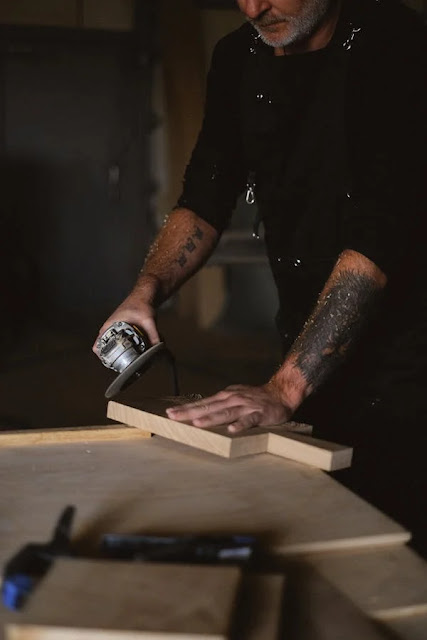How does woodworking work?
A Beginner's Guide to the Wonderful World of Woodworking
Have you ever admired a beautifully crafted piece of furniture and thought, "I could make something like that!"? Well, you're absolutely right! Woodworking, the art of transforming raw timber into functional and exquisite objects, is a surprisingly accessible hobby that offers a multitude of rewards. Whether you yearn to create heirloom-quality furniture, charming homeware, or simply relish the therapeutic satisfaction of working with your hands, woodworking can be a deeply fulfilling pursuit.
Wood you believe it? Transform your home with the magic of woodworking. Unleash your creativity!
This comprehensive guide dismantles the mystique surrounding woodworking, equipping you with the knowledge and confidence to embark on your creative journey. We'll delve into essential safety practices, fundamental tools and techniques, explore the captivating world of wood itself, and guide you towards selecting the perfect project to kickstart your woodworking adventure. So, brew a pot of tea, settle in comfortably, and let's unveil the magic behind transforming a simple plank into something truly extraordinary.
Safety First: The Golden Rule of the Woodworking Workshop
Before the symphony of sawing and sanding commences, safety should be your top priority. Woodworking tools, while incredibly useful, demand respect. Familiarizing yourself with proper tool usage techniques is paramount to preventing accidents. Here are some crucial safety pointers to remember:
- Always wear eye protection: Eye safety glasses are an absolute must. Tiny wood chips or sawdust can easily become airborne during cutting or sanding, posing a significant risk to your eyes. Invest in a comfortable pair of safety glasses that provide a good seal.
- Don't underestimate the power of ear defenders: Power tools can generate significant noise levels. Protect your hearing by using ear defenders, especially when working with loud machinery like saws and routers.
- Sharp tools are safer tools: Dull blades are more prone to grabbing or slipping, potentially causing injury. Make sharpening your tools a regular practice to ensure clean and precise cuts.
- Utilize push sticks and clamps: Never reach over a spinning blade. Employ push sticks to safely feed wood through saws, and always securely clamp workpieces to your workbench for stability.
- Know your limits: Don't attempt projects that exceed your current skill level. As your experience grows, so too will the complexity of the pieces you create.
Building Your Woodworking Arsenal: Tools for the Aspiring Artisan
Now that safety is covered, let's explore the basic tools that will form the foundation of your woodworking workshop. Remember, there's no need to invest in a vast collection right away. Start with a core set and expand as your skills develop:
- A reliable measuring tape: A dependable measuring tape is crucial for accurate cuts and ensuring all your components fit together seamlessly.
- The precision of a square: A square guarantees your cuts are perfectly straight or at the exact angle you require. There are various types of squares available, such as a try square, a combination square, and a speed square – choose the one that best suits your projects.
- A trusty handsaw for basic cuts: While power tools offer efficiency, a good handsaw, such as a backsaw or a Japanese ryoba, is a versatile tool for making precise cuts, particularly valuable for smaller projects.
- The versatility of a jigsaw: A jigsaw allows you to create intricate curved cuts, perfect for crafting decorative shapes or joinery features.
- A drill and drill bits for secure fastenings: A drill is essential for creating pilot holes and driving screws for secure joinery. Ensure you have a good selection of drill bits for different screw sizes and wood types.
- A sander for a smooth finish: Sanding is vital for achieving a professional-looking finish on your project. Start with a hand sander and a variety of grits (rough to fine) for versatility.
Optional but helpful power tools:
- A router for decorative details: A router opens doors to a world of creative possibilities. It allows you to add decorative edges, grooves, and other design elements to your projects.
- A mitre saw for accurate cuts: A mitre saw excels at making precise angled cuts, particularly useful for creating frames, picture boxes, or crown molding.
Remember, several online retailers and woodworking stores offer high-quality starter kits that bundle essential tools together at a reasonable price.
Understanding the Language of Wood: Choosing the Right Timber
Just like a painter selects their perfect pigments, woodworkers have a fascinating world of wood types to explore, each with its unique characteristics, colours, and grains. Understanding the properties of different woods will significantly impact the outcome of your project:
- Hardwoods: Hardwoods, such as oak, mahogany, and walnut, are denser and more durable, making them ideal for furniture construction, cabinets, and other projects requiring long-lasting strength. However, they can be more challenging to work with for beginners due to their density.CLICK HERE TO GET BEST SECRET METHOD USED TO BETTER WORK OF WOOD EVERY MOMENT..





Comments
Post a Comment